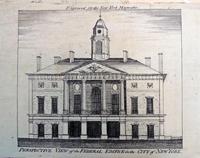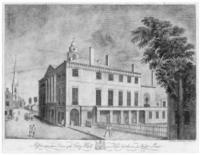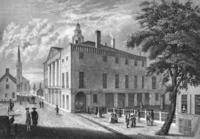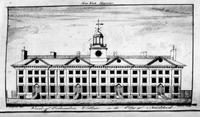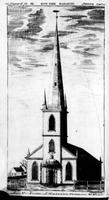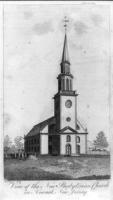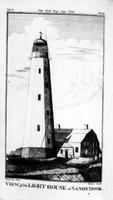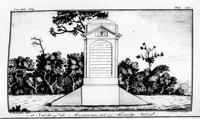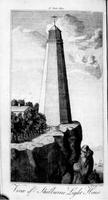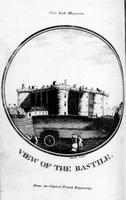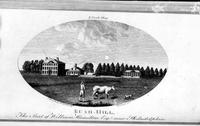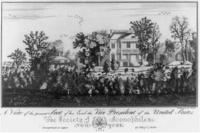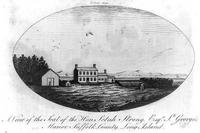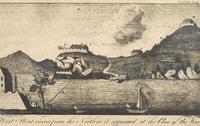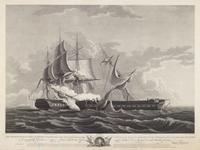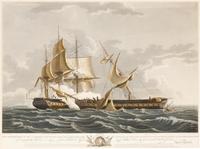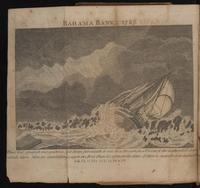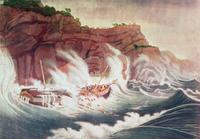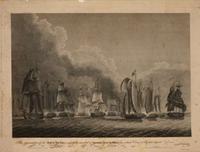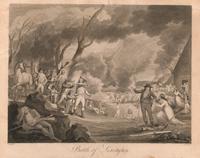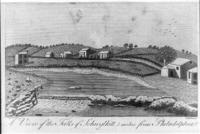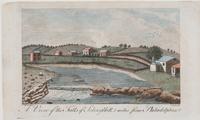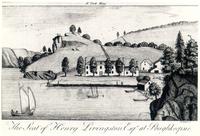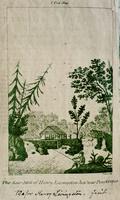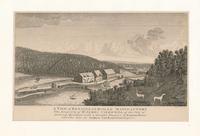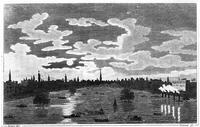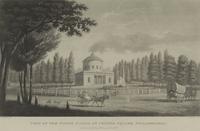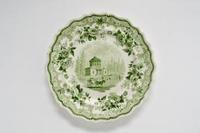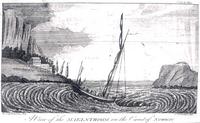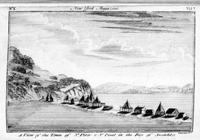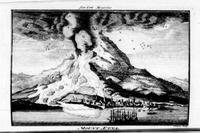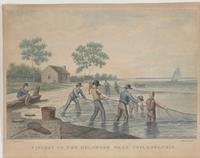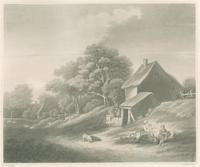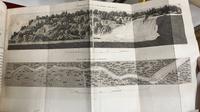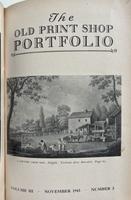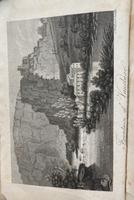Part 6. Buildings, Landscapes, Ships, Battle Scenes
In Parts 1-5, reference is made to the dependence of American engravings on publications from England. In Part 6, however, the engravings of Cornelius Tiebout, like those of other American engravers, reveal decidedly more American origins.Part 6 includes quotations in which the archaic long s is retained; that is, what appears as "f" is, in modern typography, "s", as in Congrefs. (See the Wikipedia article, Long s.)
6.1 Federal Edifice that Became City Hall
Cornelius Tiebout's engraving, "Perspective View of the Federal Edifice", appears in the carousel in both Parts 2 and 6. This engraving was published in The New York Magazine; or, Literary Repository, vol. 1, March 1790. Tiebout engraved an image of the same building, with a different name, "A Perspective View of the City Hall in New York Taken from Wall Street", which means, in the words of Gloria Gilda Deák "that the view must have been drawn about 1790, when the seat of the federal government was moved from New York to Philadelphia." (Picturing America, 1497-1899, Princeton University Press, 1988, p. 122.) The building was razed in 1812. Although Tiebout based his work on a drawing by J. Anderson, the inscription C. Tiebout Delineate & Sculpsit indicates that Tiebout was both the artist and the engraver.More than a century later, an article entitled "The Romance of Old Prints" in the New-York Tribune, 5 October 1913, page 3, noted that Tiebout's engraving, "A Perspective View of the City Hall in New York Taken from Wall Street",
is of marked interest as being the first representation of the old City Hall at about the time Washington took the oath of office, 1789 … It is unknown exactly when he was born, but he is supposed to have died in obscurity about 1830. [He died in New Harmony, Indiana in 1832.] His 'City Hall' is considered his most important and valuable work. This particular print, of which only three copies are known, has the distinction of being the most valuable of any New York view representing a single structure or street scene, the $20,000 print being a general view of 'Ye Flourishing City.' The only public record of this print of the City Hall was the sale, in 1912, at $2,935. The copy in the New York Historical Society is probably the finest of the three. [Correspondence with NYHS suggests that the reporter was, in the last two sentences, mistakenly describing a much earlier and rarer print.]
Tiebout's "City Hall" is the second image in the carousel below. It is followed by another image of the same building, dated 1902, based on Tiebout's engraving. Continuing interest in the building is shown by a recognition that it was the first Capitol of the United States (Graphic Arts, Princeton University and its place in national memory (Federal Hall National Memorial).
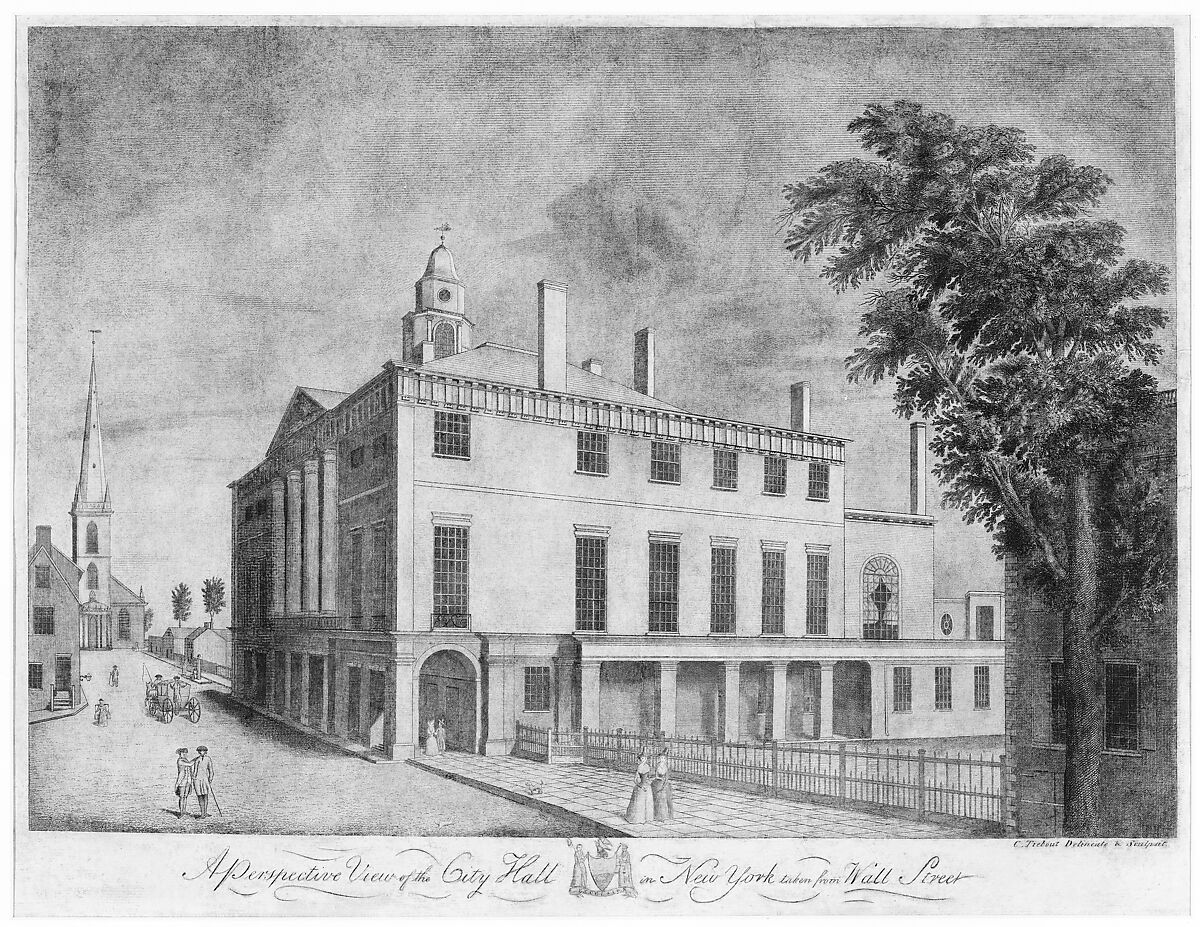
6.2 Columbia College
Another image in both Parts 2 and 6 shows the building, Columbia College, formerly named the King's College Building, as it appeared in the May 1790 issue of New York Magazine. The earlier name refers to the colonial beginnings of the college that became Columbia University. Founded in 1754 as King's College by royal charter of King George II, it is the oldest institution of higher learning in the state of New York. A book about the building, by Milton Halsey Thomas (New York, 1955), can be read online: King's College Building. The book includes Tiebout's engraving and other images of the building.6.3 Trinity Church, Wall Street
The first Trinity Church in New York City was granted a charter in 1697 by King William III. It was destroyed by fire in 1776. The second Trinity Church—the one engraved by Tiebout—was completed in 1790. The second church was weakened by storms during 1838-1839, and the third and present Trinity Church was finished in 1846. The second church was engraved twice by Tiebout. The earlier engraving was his first of 47 in The New York Magazine—this was also the first issue of the Magazine. The second was in the background of "City Hall", described just above. The church's website includes Welcome to Trinity and History of Trinity Church, where reference is made to the age in which Tiebout engraved the church: "After the war Trinity, and all Anglican churches in the former colonies, legally separated from the Church of England and became the Episcopal Church, though both remain part of the worldwide Anglican Communion…President Washington and members of his government were regular worshipers in the new Trinity building during the brief period New York City was the capital of the United States. Notable parishioners from this time include John Jay and Alexander Hamilton."6.4 Old First Presbyterian Church, Newark, New Jersey
Tiebout's engraving of "View of the New Presbyterian Church, Newark, New Jersey" was published in the September 1792 issue of The New York Magazine. Formerly a Congregational Church, this oldest church in Newark became a Presbyterian church in 1720. The church in Tiebout's engraving, third at the site, was opened on the first day of 1791. See History. Another site for the history of the church is sponsored by the Newark Public Library: NPL: "Ever since the present church has been standing at Broad Street and Branford Place, it has been one of Newark's best-known and beloved landmarks. Dozens of Presbyterian churches have been founded across the state from this mother church, including the African Presbyterian Church in 1831."6.5 Sandy Hook Light
Tiebout's engraving of this lighthouse appears in the August 1790 issue of New York Magazine. To quote from the National Park Service: "Early in the American Revolution, the expected arrival of the British fleet made the lighthouse a military target. A patriot raiding party removed 8 copper lamps and 4 casks of whale oil from the lighthouse in March 1776. In June, a daring attack to destroy the tower was attempted by Lieutenant Colonel Benjamin Tupper and his soldiers. Tupper “ordered the artillery to play, which continued an hour, but found the walls so firm I could make no Impression.” In the face of stiff resistance from a British armed guard defending the lighthouse, and supported by a British frigate in Sandy Hook Bay, Tupper called off the attack and withdrew his command. In response to the raid, the British high command took steps to protect this key navigational aid by sending loyalists to fortify the lighthouse and guard it from attack. Supported by the British Army and Navy, the loyalists kept the 'Lighthouse Fort' or 'Refugees Tower' under British control for most of the Revolution."6.5 Sandy Hook Monument (now the Halyburton Memorial)
The New York Magazine included Tiebout's engraving "A View of the Monument at Sandy Hook" in its issue of July 1790. The accompanying article includes the following inscription, which is in very small letters on the engraving:
Here lye the remains Of the Honourable Hamilton Douglas Hallyburton, fon of the late Sholto Charles Earl of Morton, heir and reprefesntative of the ancient family of Hallyburton of Pitcurr in Scotland, Firft Lieutenant of his Britannic Majesty's fhip the Affiftance;
Who perished on this coaft, with eleven more young gentlemen, and one common feaman, in the fprited difcharge of duty, the 30th and 31ft of December, 1783. Born October the 10th, 1763: A youth, who in contempt of hardfhip and danger (though in poffeffion of an ample fortune) ferved veven years in the Britifh Navy with a manly courage, and feemed to be deferving of a better fate.
To his dear Memory, and that of his unfortunate companions, this plain monumental ftone is erected by his unhappy mother, Catharine, Countefs Dowager of Morton. The names of the others who perished are then given, to be followed by these words: "Cast away! all found dead and frozen! Buried in this grave."
For further history and information about the present-day replacement of the monument, see H.M.S. Assistance Tragedy Memorial—Halyburton Monument.
Both spellings, H-a-l-l-y-b-u-r-t-o-n and H-a-l-y-b-u-r-t-o-n, have their place. See, for example, The Douglas Archives.
6.6 Shelburne Light House (Nova Scotia)
Tiebout's engraving of this site, now the Cape Roseway Lighthouse, appeared in the August 1791 issue of The New York Magazine. Quoting from Visit Shelburne County, the lighthouse was established in 1788 "on McNutt's Island at the mouth of Shelburne Harbour, Cape Roseway" and was the third lighthouse built in Canada. "It was built old world style with the cliff rocks it stands on. The rock walls were 6 feet thick and were structured with oak beams. In 1959, the lighthouse was struck by lightning and burned. The rock slabs were cracked and were replaced by the current concrete tower. The present light is 111 feet above sea level. Today the light is accessible by boat and a two mile road from the wharf."The interest that certain New Yorkers had in this lighthouse is recorded at Cape Roseway Lighthouse:
Near the close of the American Revolution, a group of about 400 families in New York formed the Port Roseway Associates and made plans to lay out a township at the head of the harbour at Port Roseway, Nova Scotia. Known as Loyalists, these British-American colonists had opposed the Revolution and remained loyal to King George III. The Crown promised free land, tools, and provisions to entice them to settle in a relatively undeveloped area. In the spring of 1783, more than 5,000 settlers from New York and neighbouring colonies left their homes and sailed north to Port Roseway. John Parr, governor of Nova Scotia, visited the settlers shortly after their arrival and renamed the settlement Shelburne after the current Prime Minister of Great Britain. Waves of additional Loyalists followed that fall, and, by 1784, the population of Shelburne numbered more than 10,000, making it the fourth largest community in North America. The government ceased the distribution of provisions in 1787, and not long thereafter, many settlers put their houses up for sale and left to try their luck elsewhere. By the 1820s, the population of Shelburne had dwindled to about 300.
6.7 The Bastille (Paris)
The title page of the April 1790 issue of The New York Magazine shows, prominently displayed: "This Number is ornamented with an elegant engraved Copper-Plate, reprefenting a View of the BASTILE in France." The same spelling occurs in the article and engraving itself. Less than a year before the publication of the article, on 14 July 1789, the Bastille, a castle once used as a state prison, had been stormed during the French Revolution. See Storming of the Bastille. The Magazine article describes the rooms of the Bastille in detail, and includes these words: "A furgeon and three chaplains refide in the daftle. If prifoners of note are dangeroufly ill, they are generally removed, that they may not die in this prifon…A library was founded by a pifoner, who was a foreigner, and died in the Bastile the beginning of the prefent century. Some prifioners obtain permiffion to have the ufe of it."6.8 Bush Hill
Tiebout's engraving of Bush Hill is found in the February 1793 issue of The New York Magazine. The accompanying article is short enough to be quoted here in full:Account of Bufh-Hill, the Seat of Wm. Hamitton, Efq; near Philadelphia
THE high and beautiful fituation of Bufh-Hill is perhaps not exceeded by any feat in the vicinity of Philadelphia—It commands a very extenfive and grand profpect of fome miles around, including the whole city, and the rivers Delaware and Schuylkill for a confiderable diftance above and below the city.
This once elegant Villa has not yet recovered from the ftate of almoft total demolition, which it fuffered from the hands of a furious and inveterate enemy. The gravel walk, however, and the delightful grove of cedar trees, remain entire. There are alfo feveral fine ftatues of marble yet ftanding, whilft others are lying about broken and neglected. The fpacious lawn in the front is remarkable for being the place of the celebration of the memorable grand proceffion and fete, on the 4th of July, 1788, occafioned by the adoption of the Conftitution of the United States— from which event it has obtained the name of Union Green.
Bush Hill played an important role as a hospital during the yellow fever epidemic in Philadelphia. As described by Ryan P. Langton, "In need of a hospital dedicated to yellow fever patients, Mayor Clarkson directed the remaining Guardians of the Poor to use Bush Hill Mansion, located just north of the city near what is now Matthias Baldwin Park, for use as a hospital. Bush Hill’s owner had been away on an extended trip to England, allowing the empty mansion to be quickly converted into a hospital.
6.9 A View of the present Seat of his Excel the Vice President of the United States
Tiebout's engraving of Richmond Hill, the home of Vice-President John Adams, appears in the June 1790 issue of The New York Magazine. The accompanying article is quoted here:THE annexed plate is a view of the country feat, the property of Mrs. Jephfon, the prefent refidence of John Adams, Efq; VicePrefident of the United States of America. It is beautifully fituated, near the city of New-York, on the Banks of the Hudfon, of which it commands en extenfive profpect. The venerable oaks, and broken ground, covered with wild fhrubs, give it a very romantic air. This place was formerly the head-quarters of the President, when Commander in Chief of the American army, at the commencement of the late war.
This estate was once the headquarters for George Washington. Its location and history are described in Richmond Hill (Manhattan).
6.10 A View of the Seat of the Hon. Selah Strong
Tiebout's engraving of the residence of Judge Selah Strong appears in the October 1792 issue of The New York Magazine. The accompanying article is quoted here:THE Seat of the Hon. Judge Strong, which the annexed Plate is defigned to reprefent, ias fituated in the townfhip of Brookhaven, in the county of Suffolk, about fixty miles from New-York, and is called St. George’s Manor. It is a peninfula within the harbour of Setauket, joined at the fouth-weftermoft end by a very narrow ifthmus to Long-Ifland, with the harbour and bay between it and the town. The beach and ftraight which feparate it from the Sound, on the north, are both very narrow, and do not intercept the view of the Sound. It affords a very beautiful and picturefque profpect to travellers pafling through Setauket, and to voyagers failing up and down the Sound—To vifitors, it prefents a beautiful landfcape of the town, and the adjacent hills and woods.—Tho’ its appearance has been greatly injured by the neglect of the former proprietor, and the influence of the late war, yet the prefent poffeffor is making much improve- ments as conduce to the real conveniencies of life.
The foil is very fertile, and natural to moft kinds of grain or grafs—In fhort, it is a farm calculated to employ the induftrious hufbandman, or fuitable for the man of independence and eafe.
Judge Strong's full name was Selah Brewster Strong II (1737-1812). He was a captain in the New York militia in 1776. He and his wife, Anna Smith Strong (1740-1812) were spies for George Washington. See Mark Sternberg's "Selah Strong: Records Reveal an Overlooked Hero of the Culper Spy Ring," New York Archives, vol. 22, no. 2, Fall 2022, pp. 11-17: Selah Strong (New York Archives. For family history and the place of Anna and Selah Strong in 21st century popular culture, see Wikipedia: Anna Strong (spy). Visit also St. George's Manor Cemetery, which includes a picture of the grave of Captain Selah Strong & Anna Smith Strong.
6.11 West Point Viewed from the North
Tiebout's engraving of West Point appears in the March 1791 issue of The New York Magazine. The accompanying article is quoted here.West Point became the United States Military Academy in 1802, a decade before Tiebout's engraving of West Point was published. To quote from the West Point website, History, "In the 1790s several distinguished Americans, including President Washington and most of his cabinet, desired to establish an institution devoted to the art and science of warfare to train and develop officers for the Army. However, the proposal met opposition, especially from Secretary of State Thomas Jefferson, who objected to the concept based on his opposition to professional armies and the officer class so prominent in Europe. Later, as president, Jefferson realized the importance of defending the new republic against possible invasion. Additionally, the nation’s expansion west with new territory would require an armed force for protection and defense. President Jefferson signed legislation that established the United States Military Academy on March 16, 1802.THIS formidable fpot of ground is on the weft fide of Hudfon’s River, fixty miles north of the city of New-York; and at this day, altho’ its former defences are many of them entirely obliterated, and the reft mouldering into ruin, exhibits marks of furprifing ftrength. It flood, during moft part of the late war, the bulwark of the confederated flates, and the terror of the Britifh arms. It is faid, that the very common foldiers of the Englifh army, however prone to ridicule the American fortifications, never mentioned this in a ludicrous manner.
Once indeed, the idea of its fubjugation was cherifhed ; but then it was to be effected by treachery: yet, ftill it flood, and mocked the wiles as well as the force of its enemies.A. Conflitution Ifand, on the eaft fide of the river.
B. A chain, fufpended on pontoons, reaching quite acrofs Hudfon’s River, there about 450 yards wide.
C. Fort Clinton, the principal work, intended to annoy any naval force that might attempt the paffage.
D. Fort Putnam, a very ftrong fortrefs on the fummit of a mountain, about half a mile from the point, and which commanded all the plain beneath.
Befides thefe, there were a chain of forts reaching far weft of Putnam; two confiderable redoubts on mountains on the eaft fide of the river; and 4 number of batteries nearly level with, the river.
6.12 The Constitution defeats the Guerrière, 12 August 1812
One of Tiebout's best known engravings, after Thomas Birch (1779-1851), has the following full title:
THIS REPRESENTATION OF THE U. S. FRIGATE CONSTITUTION, ISAAC HULL, ESQr. COMMANDER, CAPTURING HIS BRITANNIC MAJESTY'S FRIGATE GUERRIERE, JAMES H. DACHES, ESQr. COMMANDER; is respectully inscribed to Capt. Isaac Hull, his Officers and Gallant Crew by their Devoted humble Servant, James Webster.
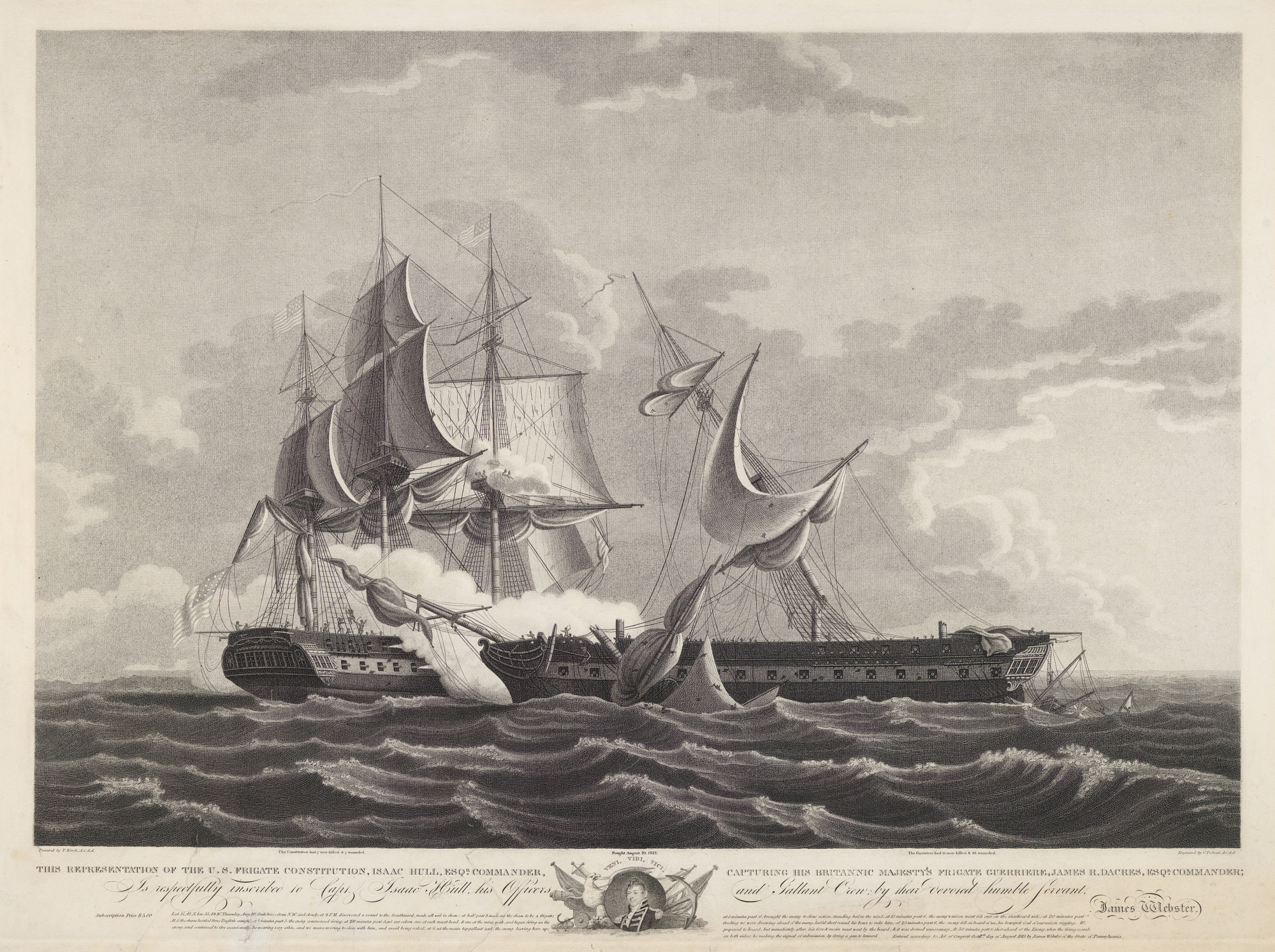
In italics, the note "Subscription price $5.00" is followed by a lengthy account quoted below. This account is in two sections, separated by a portrait of Issac Hull, surrounded by naval ornamentation and the Latin phrase: Veni, Vide, Vici. In tiny lettering to the lower right of this mid-section is the name of [David] Edwin (1776-1841, a British-born Philadelphia engraver. Following is the lengthy account:
Lat. 41, 42, N. lon. 55, 48, W. Thursday, Aug. 19, fresh breeze from N.W. and cloudy, at 2 P.M. discovered a vessel to the Southward, made all sail in chase; at half past 3, made out the chase to be a frigate; At 5 the chase hoisted three English ensigns; at 5 minutes past 5, the enemy commenced firing; at 20 minutes past 5, set our colors, one at each mast head, & one at the mizen peak, and began firing on the enemy, and continued to fire occasionally, he weaving very often, and we maneuvering to close with him, and avoid being raked; at 6, set the main top gallant sail, the enemy having bore up; at 5 minutes past 6, brought the enemy to close action, standing before the wind; at 15 minutes past 6, the enemy's mizen mast fell over on the starboard side; at 20 minutes past 6, finding we were drawing ahead of the enemy, luffed short round his bows to rake him; at 25 minutes past 6, the enemy fell on board of us, his bowsprit foul of our mizen rigging. We prepared to board, but immediately after, his fore & main mast went by the board, & it was deemed unnecessary. At 30 minutes past 6, shot ahead of the Enemy, when the firing ceased, on both sides; he making the signal of submission by firing a gun to leeward. Entered according to Act of Congress the 18th day of August 1813 by James Webster of the State of Pennsylvania.
This engraving represents a battle during the War of 1812. The United States had won independence from Britain more than thirty yearts earlier, and the new republic, in 1812, was eager to show its military prowess to the world. Thomas Birch, a Philadelphia-based painter born in Warwickshire, England, painted more than twelve pictures of naval battles, following the example of contemporary historical painting begun by Benjamin West (eminent Pennsylvania-born artist in London, in whose large house Tiebout resided during 1793-1796). Birch's paintings were praised "not only for their sense of immediacy, but also for their appeal to the patriotic fervor of the new country." These words accompany the online picture of Birch's painting in the Museum of Fine Art, Boston (Engagement Between the "Constitution" and the "Guerriére").
However, within five minutes of comparing Birch's painting in the Boston museum with Tiebout's engraving, you can find a number of substantial differences. A second of Birch's painting of this battle scene, entitled "Constitution and Guerriere", is preserved in the Philadelphia Museum of Art (the painting in Philadelphia). This image, too, differs from Tiebout's engraving, which is all the more understandable if the date shown, 1831, instead of 1813, is correct. To conclude, it appears that the specific Birch painting used by Tiebout may be lost or privately owned.
In about 1845, the British-born American artist Thomas Chambers (1808-1866) painted "The Constitution and the Guerriere" after Tiebout's engraving; you can view it at The Met.
6.13 Bahama Banks, 1767
Tiebout engraved two plates for the American edition (1791) of The Interesting Narrative of the Life of Olaudah Equiano, or Gustavus Vassa, the African. Written by Himself, after two similar plates in the London edition of 1789. Both the English plate (with "Barnes and Co Sc" as engraver) and Tiebout's appear in the carousel below.The American edition of Narrative can be viewed online from the Library of Congress, and a transcription is available from Project Gutenberg.
The book is described and summarized in the Wikipedia article, The Interesting Narrative of the Life of Olaudah Equiano. The article notes that the book is the autobiography of Olaudah Equiano. "The narrative is argued to represent a variety of styles, such as a slavery narrative, travel narrative, and spiritual narrative. The book describes Equiano's time spent in enslavement, and documents his attempts at becoming an independent man through his study of the Bible, and his eventual success in gaining his own freedom and in business thereafter." The article also recognizes three main themes:
Slavery in West Africa vs. slavery in the Americas
The African slave's voyage from Africa (Igbo Land) to the Americas and England
The cross-cultural and geopolitical journey from slavery to freedom and heathenism to Christianity.
There is a separate Wikipedia article about the author: Olaudah Equiano For a view of the English engraving and information, including the engraver's name, Samuel Atkins, see Royal Museums Greenwich. The original (English) engraving is preserved in the John Carter Library, Brown University.
A portion of the book that describes the storm at Bahama Banks, in Chapter III, volume 1, is quoted here:
We then proceeded on our voyage; but the day after we left the island, late in the evening, and whilst we were yet amongst the Bahama keys, we were overtaken by a violent gale of wind, so that we were obliged to cut away the mast. The vessel was very near foundering; for she parted from her anchors, and struck several times on the shoals. Here we expected every minute that she would have gone to pieces, and each moment to be our last; so much so that my old captain and sickly useless mate, and several others, fainted; and death stared us in the face on every side. All the swearers on board now began to call on the God of Heaven to assist them: and, sure enough, beyond our comprehension he did assist us, and in a miraculous manner delivered us! In the very height of our extremity the wind lulled for a few minutes; and, although the swell was high beyond expression, two men, who were expert swimmers, attempted to go to the buoy of the anchor, which we still saw on the water, at some distance, in a little punt that belonged to the wrecker, which was not large enough to carry more than two. She filled different times in their endeavours to get into her alongside of our vessel; and they saw nothing but death before them, as well as we; but they said they might as well die that way as any other. A coil of very small rope, with a little buoy, was put in along with them; and, at last, with great hazard, they got the punt clear from the vessel; and these two intrepid water heroes paddled away for life towards the buoy of the anchor. The eyes of us all were fixed on them all the time, expecting every minute to be their last: and the prayers of all those that remained in their senses were offered up to God, on their behalf, for a speedy deliverance; and for our own, which depended on them; and he heard and answered us! These two men at last reached the buoy; and, having fastened the punt to it, they tied one end of their rope to the small buoy that they had in the punt, and sent it adrift towards the vessel. We on board observing this threw out boat-hooks and leads fastened to lines, in order to catch the buoy: at last we caught it, and fastened a hawser to the end of the small rope; we then gave them a sign to pull, and they pulled the hawser to them, and fastened it to the buoy: which being done we hauled for our lives; and, through the mercy of God, we got again from the shoals into deep water, and the punt got safe to the vessel. It is impossible for any to conceive our heartfelt joy at this second deliverance from ruin, but those who have suffered the same hardships. Those whose strength and senses were gone came to themselves, and were now as elated as they were before depressed. Two days after this the wind ceased, and the water became smooth.
For details on the reception of Equiano's book in England and America, see Akiyo Ito, "Olaudah Equiano and the New York Artisans: The First American Edition of 'The Interesting Narrative of the Life of Olaudah Equiano, or Gustavus Vassa, the African'", Early American Literature, vol. 32, no. 1 (1997), pp. 82-191.
6.14 Loss of the Packet Ship Albion
"The packet ship Albion, sailing from New York to Liverpool, was wrecked on the cast of Ireland on April 22, 1822. Of the 54 people on board, only 9 survived." This introduction is followed by a detailed study of the loss, portrayed in Tiebout's engraving after the painter Thomas Birch. See Shannon Selin, The Wreck of the Packet Ship Albion. and Albion Packet Ship.6.15 Battle of Lake Erie
Tiebout's work in this case is as etcher rather than engraver. The scene is based on a drawing by Thomas Sully (1783-1872) and Francis Kearny (1785-1837), and the engraver was George Murray (d. 1822). The battle was fought on 10 September 1813, and the print was published 26 July 1815 by Murray, Draper, Fairman & Co. and J. Webster of the State of Pennsylvania. For details, see Naval History, Battle of Lake Erie, and First view of the battle.6.16 Battle of Lexington
Tiebout's engraving of this battle scene is after the painter Elkanah Tisdale (1768?-1835). The print was published by Tiebout and his brother Alexander, No. 29 Gold Street, New York, 1 January 1798, and also in The Columbian War; or Battles for American Independence, no. 1 (New York, 1798). For information about the battle, see Wikipedia: Battles of Lexington and Concord.6.17 Falls of Schuylkill
Tiebout's engraving of his scene, after a drawing by Jacob Hoffman, appears in the May 1793 issue of The New York Magazine. The accompanying article has this to say:
Of all the obfthructions by which the navigation of the Schuykill is interrupted, that of the Lower Falls, in the annexed view reprefented, is by far the moft formidable. Thefe Falls are about five miles above Philadelphia, and twelve miles from the River's mouth…Although the Falls are no longer there, the name Falls of Schylkill is that of the town, some of whose early buildings appear in the engraving. There was once a nearby Chain Bridge at the Falls of Schuykill.
The hazardous attempt of passing through thefe Falls will be entirely removed when the Canal, now digging, becomes completed, which will connect the waters of the Delaware and Schuylkill, and, when, the moft dangerous impediments in the Schuykill are removed, render the navigation perfectly fafe; and will alfo, in conjunction with the Canal to unite the waters of the Sufquehannah and Schuylkill, tend to form a grand communication between the western parts of the ftate and the city of Philadelphia.

